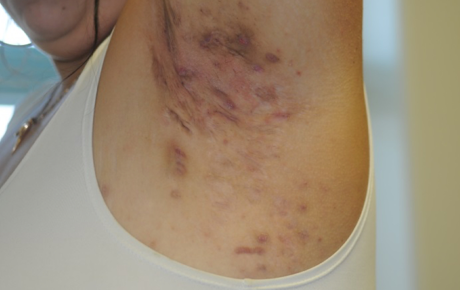What is HS?
HS is a chronic, progressive, inflammatory skin disease characterized by painful recurrent lesions, often with malodorous purulent discharge. This immune-mediated disease is believed to be caused by systemic inflammation, not an infection—although secondary infection can often occur.1-5
Find HS information that’s important to you.
Choose your specialty:

Photo courtesy of Dr. Marc Bourcier.

Photo courtesy of Dr. Marc Bourcier.
Where HS typically occurs
HS lesions typically occur in areas of the body where skin rubs together—most commonly the axillary, groin, perianal, perineal, and inframammary areas. As the disease progresses, symptoms can become debilitating, as extensive sinus tract formation and scarring occur.3-5
Early diagnosis and appropriate treatment are believed to improve prognosis and limit lasting and disabling damage.3
HS Treatment Options
There are important considerations when developing a multi-modal management plan.6
Co-managing HS With a Specialist
Partner with an experienced HS specialist in dermatology to co-manage your HS patients.
REFERENCES
1. Jemec GBE. Hidradenitis suppurativa. N Engl J Med. 2012;366(2):158-164. 2. Kurzen H, Kurokawa I, Jemec GBE, et al. What causes hidradenitis suppurativa? Exp Dermatol. 2008;17(5):455-472. 3. Micheletti RG. Natural history, presentation, and diagnosis of hidradenitis suppurativa. Semin Cutan Med Surg. 2014;33(suppl 3):S51-S53. 4. Kerdel FA, Menter A, Micheletti RG. Introduction. Semin Cutan Med Surg. 2014;33(suppl 3):S47. 5. Alikhan A, Lynch PJ, Eisen DB. Hidradenitis suppurativa: a comprehensive review. J Am Acad Dermatol. 2009;60(4):539-561. 6. Lockwood SJ, Prens LM, Porter ML, Kimball AB. Treatment of hidradenitis suppurativa. In: Kimball AB, Jemec GBE, eds. Hidradenitis Suppurativa: A Disease Primer. Switzerland: Springer International Publishing AG; 2017:39-51.
